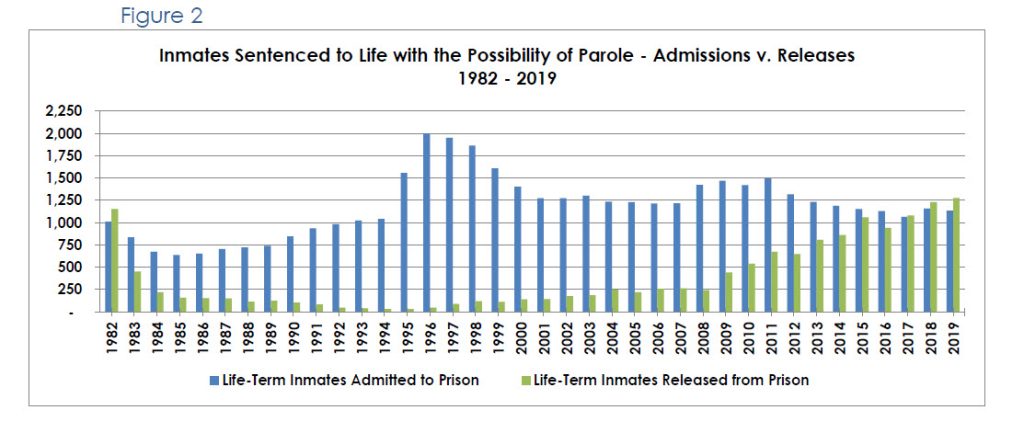CHANGES IN THE LAW EXPANDING PAROLE ELIGIBILITY FOR LONG‑TERM OFFENDERS
Prior to 2014, only persons sentenced to “life with the possibility of parole” were eligible for a parole hearing and they were required to serve the minimum sentence imposed by the court before they were eligible for a hearing (less any applicable credits).24 There are 33,676 of these persons in prison today.25
However, despite being sentenced to life “with the possibility of parole,” many of these persons received sentences where their minimum eligible parole date exceeds their natural life. For example, there are 6,166 persons in prison today sentenced to life with the possibility of parole who, based on the sentence imposed by the court, would need to serve an additional 40 years before they would be eligible for a parole hearing. Approximately 1,528 of these persons would need to serve 100 to 600 years before they would be eligible for a parole hearing and 265 would need to serve more than 600 years before they would be eligible for a parole hearing.
There are also some determinately-sentenced persons in prison who are sentenced to lengthy terms of imprisonment. For example, there are 295 persons in prison today who, based on the sentence imposed by the court, would need to serve more than 40 years before reaching their release date. Forty of these inmates would need to serve an additional 100 to 600 years, and one would need to serve more than 600 years.
With the exception of persons sentenced to life without the possibility of parole or condemned, all inmates now have an opportunity for parole during their natural life under youth offender parole, elderly parole, or Proposition 57.
Youth Offender Parole, Elderly Parole, and Proposition 57 Parole Hearings
As previously noted, prior to 2014, only persons sentenced to life with the possibility of parole were eligible for parole consideration by the Board and only after they served the minimum sentence imposed by the court. Since 2014, however, a series of legislative measures, ballot initiatives, and court cases have both expanded the number of persons eligible for a parole hearing and made many persons eligible for a parole hearing earlier in their incarceration period.
For example, indeterminately and determinately-sentenced persons who committed their controlling offense26 while under the age of 26 are now eligible for a youth offender parole hearing after serving 15, 20, or 25 years (depending on the length of the sentence imposed by the court).27 Exclusions apply.28 Persons who were under the age of 18 and who were sentenced to life without the possibility of parole are eligible for a youth offender parole hearing after serving 25 years.29
In addition, effective January 1, 2021, inmates who are both age 50 and who have served at least 20 years will be eligible for an elderly parole hearing under Penal Code section 3055.30 Exclusions apply.31 Inmates who are age 60 and who have served at least 25 years are also eligible for an elderly parole hearing under a court order issued by the Three Judge Panel in the Plata/Coleman class action litigation.32 Under the court order, only persons sentenced to life without the possibility of parole or condemned are excluded.
Lastly, indeterminately-sentenced nonviolent offenders (i.e., “nonviolent third strikers”) are eligible for a parole hearing under Proposition 57 once they have served the full term of their primary offense.33
As shown in Figure1 below, the result of these changes is that there are now 41,464 determinately and indeterminately-sentenced persons who are eligible for a parole hearing, which means 7,788 long-term inmates are eligible for a parole hearing today who would not have been eligible for one in 2013.34 In addition, 38,523 (93 %) of the 41,464 long-term inmates who are now eligible for a parole hearing have either already had a parole hearing or will have one in the next 20 years.

As shown in Figure 2 below, changes in the law and increases in parole grants have shifted the balance between the number of life-term-inmates admitted to CDCR annually and the number of life-term inmates released from state prison. This culminated in 2017 being the first time in 34 years that more life-term inmates were released from state prison than were admitted to state prison in California. Please see Appendix B for a summary of select changes in the law governing sentencing and parole over the past 10 years.

